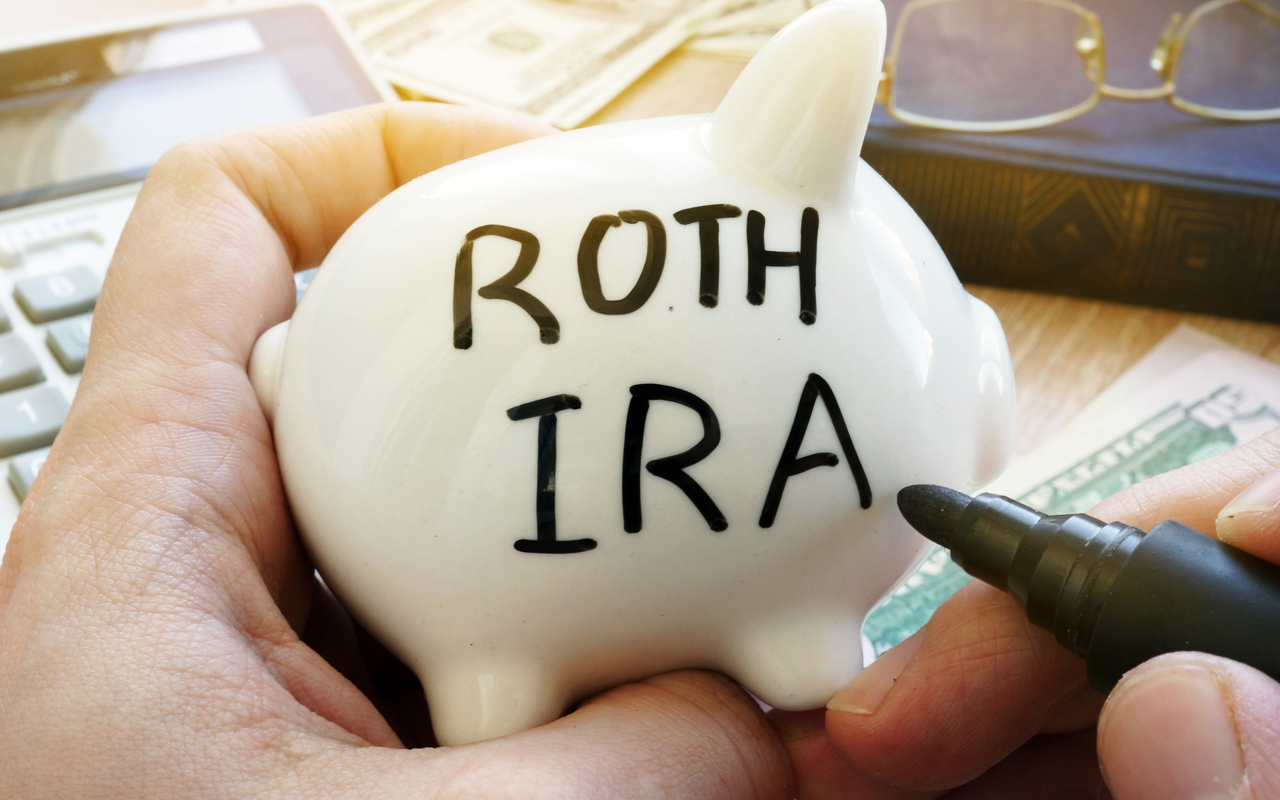
Tax-free income is the dream of every taxpayer. And if you save in a Roth account, it's a reality. Roths are the youngsters of the retirement savings world. The Roth IRA, named after the late Delaware Sen. William Roth, became a savings option in 1998, followed by the Roth 401(k) in 2006. Creating a tax-free stream of income is a powerful retirement tool. These accounts may offer big benefits, but the rules for Roths can be complex.
Here are 10 things you must know about utilizing a Roth IRA as part of your retirement planning.
1. With a Roth IRA you pay taxes now instead of later
Roths turn traditional IRA and 401(k) rules on their head. Rather than getting a tax break for money when it goes into the account and paying tax on all distributions, with a Roth, you save after-tax dollars and get tax-free withdrawals in retirement.
By accepting the upfront tax breaks for traditional IRA accounts, you accept the IRS as your partner in retirement. If you're in the 24% tax bracket in retirement, for example, 24% of all your traditional IRA withdrawals — including your contributions and their earnings — will effectively belong to the IRS. With a Roth, 100% of all withdrawals in retirement are yours.
The Roth strategy of paying taxes sooner rather than later will pay off particularly well if you're in a higher tax bracket when you withdraw the money than when you passed up the tax break offered by the traditional account. If you're in a lower tax bracket, though, the Roth advantage will be undermined.
2. There are Roth IRA contribution limits
To be able to contribute to a Roth, you must have earned income. You are also limited to stashing up to $7,000 in a Roth IRA and an extra $1,000 if you're 50 or older for 2024. These contribution limits will remain unchanged for 2025, but the income limits will increase slightly. You can contribute to both Roth and traditional IRAs, but the total cannot exceed this annual limit.
But higher-income taxpayers are barred from contributing to a Roth IRA. For 2025, the ability to contribute to a Roth phases out if your modified adjusted gross income (MAGI) is between $150,000 and $165,000 for singles and heads of household, up from between $146,000 and $161,000 in 2024. For those married and filing jointly, the phase out range in 2025 is between $236,000 and $246,000, up from a range of $230,000 to $240,000 in 2024.
Contributions begin phasing out above those amounts, and you can't put any money into a Roth IRA once your income reaches $165,000 if you are a single filer or $246,000 if married and filing jointly.
You can make a 2024 Roth IRA contribution as late as April 15, 2025.
3. Your company may offer a Roth 401(k)
Many companies have added a Roth option to their 401(k) plans. After-tax money goes into the Roth, so you won't see the immediate tax savings you get from contributing pretax money to a traditional plan. But your money will grow tax-free. (Any employer match will go into a traditional 401(k) account.)
For 2025, you can stash up to $23,500 a year, up from $23,000 in 2024, plus an extra $7,500 a year if you're 50 or older, into a Roth 401(k).
Contributions must be made by December 31 to count for the current tax year, and the limit applies to the total of your traditional and Roth 401(k) contributions. A Roth 401(k) is a good option if your earnings are too high to contribute to a Roth IRA.
4. You can do a Roth conversion
Another route to tax-free earnings inside a Roth is to convert traditional IRA money to a Roth. In the year you convert, you must pay tax on the full amount shifted into the Roth. That's the price you pay to buy tax freedom for future earnings. (If you have made nondeductible contributions to your traditional IRA, a portion of your conversion will be tax-free).
If you expect your tax rate to be the same or higher in the future, converting could make sense; if you expect your future tax rate to be lower, it might not.
You'll want to pay the tax owed on a conversion with money outside of the IRA. Drawing money from the IRA to pay the tax will result in an additional tax bill, and a penalty if you're under age 59-1/2.
Before you jump into a Roth conversion, make sure you understand the potential downsides. The most important is that a Roth conversion could trigger other taxes.
Look at the big picture if you plan a conversion. The added taxable income could boost you into a higher tax bracket, at least temporarily. A big jump in income could trigger one-time taxes, too, such as the Medicare surtax — an extra 0.9% tax applied to higher-income earners: $200,000 for individuals and $250,000 for married couples filing jointly.
A series of small conversions over several years could keep the tax bill in check. For instance, you may want to convert just enough to take you to the top of your current tax bracket.
5. Roth IRAs have hidden tax benefits
There is a great tax benefit to a Roth IRA. These accounts give you a pot of tax-free income to draw upon that may allow you to lower your tax bill.
Roth money doesn't count in the calculation for taxing Social Security benefits, for example, or in the calculation for the tax on investment income.
6. Roth IRAs have no required minimum distributions
One significant advantage of a Roth IRA is that these accounts do not have required minimum distributions (RMDs). That means you are not forced to take out a certain amount each year so these funds can remain in the Roth IRA, earning tax-free. Other types of retirement accounts, including traditional IRAs and most 401(k)s, do have RMDs.
These rules are different for inherited Roth IRAs and starting in 2024, RMDs won’t be required for designated Roth 401(k) accounts.
7. Roth IRA withdrawal rules
If you do decide to withdraw funds from your Roth IRA, there are rules to follow to avoid taxes and penalties.
Because there's no tax deduction for Roth contributions, you can retrieve that money at any time free of taxes and penalties, regardless of age.
But for earnings to be tax- and penalty-free, you have to pass a couple of tests. First, you must be 59-1/2 or older. You will get hit with a 10% early withdrawal penalty and taxes if you take out earnings before you hit that age. And you must have had one Roth open for at least five years. If you are 58 and opening your first Roth IRA in 2025, you can tap earnings penalty-free at age 59 1/2, but you won't be able to tap earnings tax-free until 2030.
If you make a conversion, you must wait five years or until you reach age 59-1/2 before you can withdraw the converted amount free of the 10% penalty. The clock for those five years starts on January 1 of the year that you make the conversion. You could make the conversion late in a year, meaning you only have to wait closer to four years before you can touch earnings without penalty.
Each conversion has its own five-year holding period. So if a young account owner does one conversion in 2025 and a second conversion in 2026, the amount from the first conversion can be withdrawn penalty-free starting in 2030 and the amount from the second starting in 2031.
Earnings on a converted amount can be withdrawn tax- and penalty-free after the owner reaches age 59-1/2, as long as he or she has had any Roth IRA opened for at least five years.
The rules for determining the source of money coming out of a Roth work in the taxpayer's favor. The first money out is considered contributed amounts, so it's tax- and penalty-free. Once contributions are depleted, you dip into converted amounts (if any). This money is tax- and penalty-free for owners 59 1/2 and older or younger ones who have had the converted amount in a Roth for more than five years.
Only after you have cashed out all converted amounts do you get to the earnings. Once the account owner is 59-1/2 and has had one Roth for at least five years, earnings, too, can be withdrawn tax- and penalty-free.
8. Use a Roth IRA before retirement for other purposes
The ability to tap money in a Roth IRA without penalty before age 59-1/2 allows for flexibility to use the Roth IRA for other purposes. In essence, this account can act as an emergency fund and could be used to pay off significant unexpected medical bills or cover the cost of a child's education.
But it's best to only tap into these funds if it is absolutely necessary. And if you must withdraw any money from a Roth IRA before retirement, you should limit it to contributions and avoid taking out any earnings. If you withdraw the earnings, then you could face taxes and penalties.
9. You can still recharacterize annual Roth IRA contributions
Before 2018, the IRS allowed you to reverse converting a traditional IRA to a Roth IRA, which is called recharacterization. But that process is now prohibited by the Tax Cuts and Jobs Act of 2017.
However, you can still recharacterize all or part of an annual contribution, plus earnings. You might do this if you make a contribution to a Roth IRA and then later discover that you earn too much to be eligible for the contribution, for instance. You can recharacterize that contribution to a traditional IRA since those accounts have no income limits. Contributions can also be recharacterized from a traditional IRA to a Roth IRA.
The change would need to be completed by the tax-filing deadline of that year. The recharacterization is nontaxable but you will need to include it when filing your taxes.
10. A Roth IRA can benefit heirs
Unlike traditional IRAs — which you must begin to tap at age 73 — Roth IRAs have no minimum distribution requirements for the original owner. So, if you don't need the money, it can grow in the tax shelter until your death.
However, your heirs may have to take required minimum distributions (RMDs) on your IRA after your death. Beginning in 2025, certain heirs who inherit individual retirement accounts must take yearly required withdrawals or face penalties.
This rule applies to most non-spousal beneficiaries if the original account owner has reached the required minimum distribution age before death. So, consult with a trusted tax professional to understand how your heirs can best access funds from your IRA after your death.







